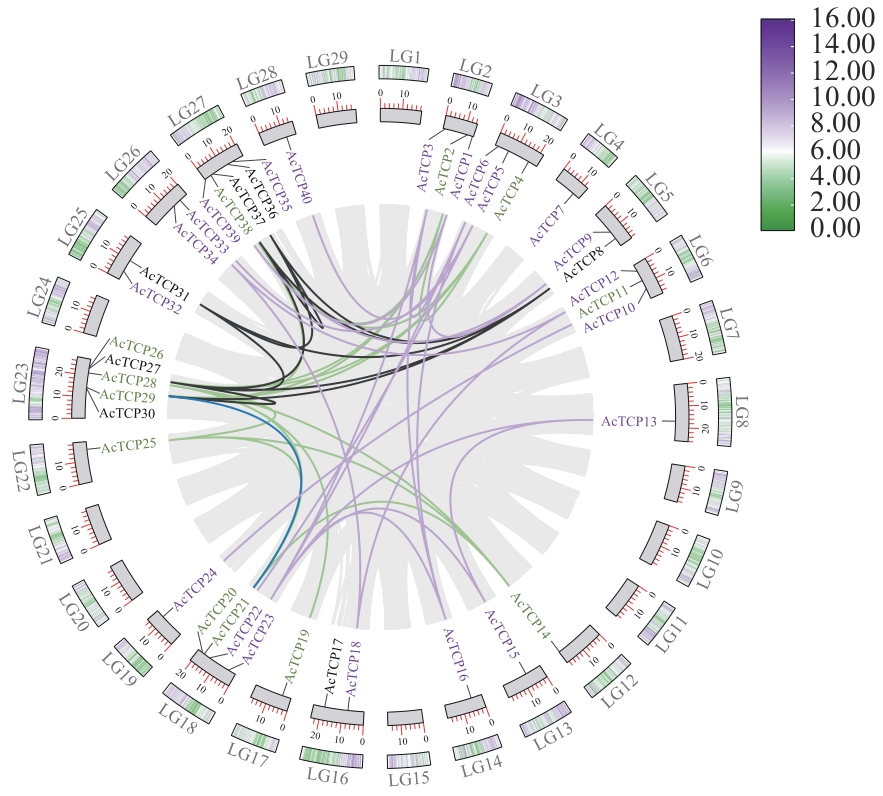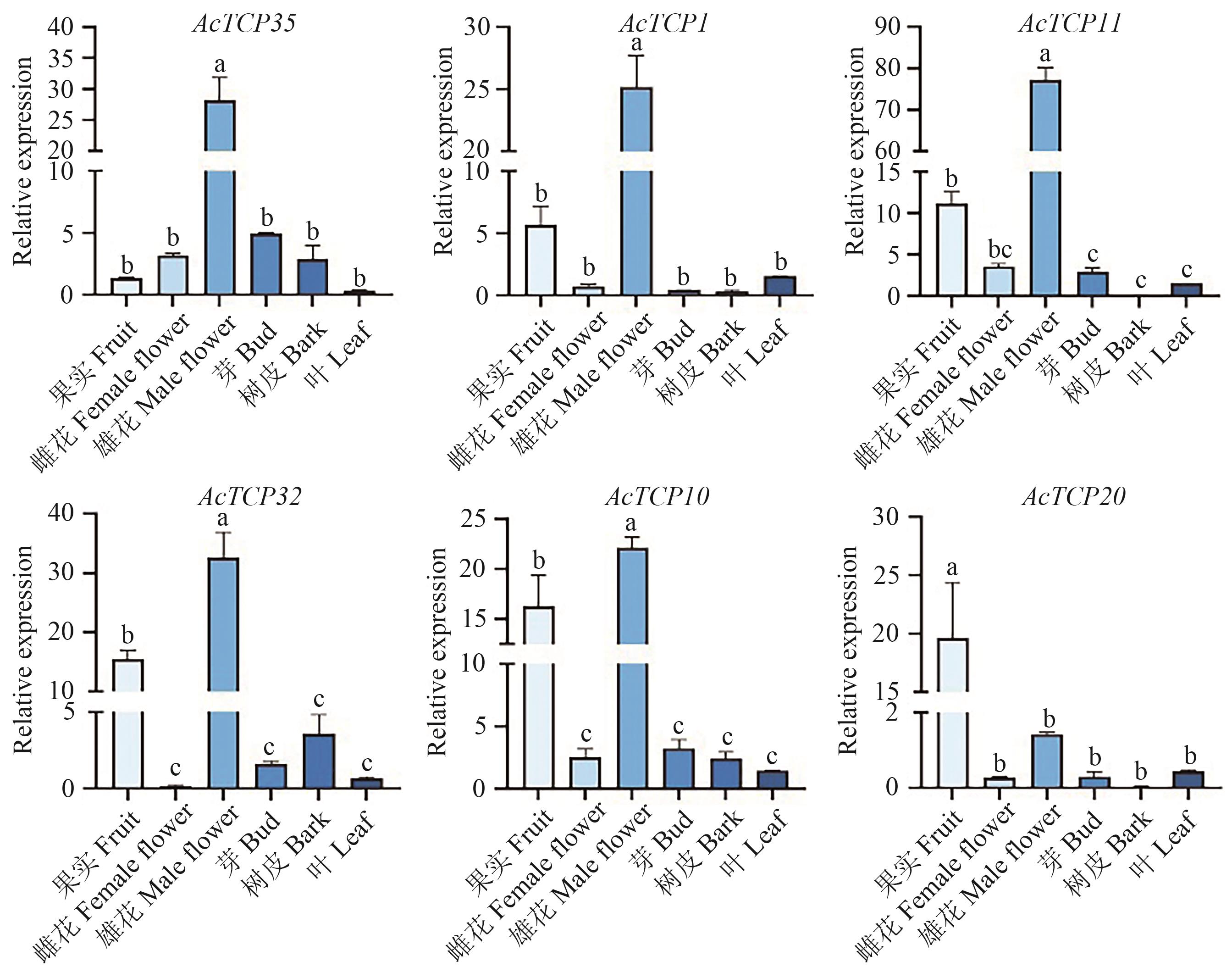








生物技术通报 ›› 2025, Vol. 41 ›› Issue (3): 190-201.doi: 10.13560/j.cnki.biotech.bull.1985.2024-0820
• 研究报告 • 上一篇
宋姝熠1,2( ), 蒋开秀2, 刘欢艳2, 黄亚成2(
), 蒋开秀2, 刘欢艳2, 黄亚成2( ), 刘林娅2(
), 刘林娅2( )
)
收稿日期:2024-08-23
出版日期:2025-03-26
发布日期:2025-03-20
通讯作者:
刘林娅,女,博士,副教授,研究方向 :植物分子遗传育种;E-mail: liulinya913@126.com作者简介:宋姝熠,女,硕士研究生,研究方向 :植物生物化学与分子生物学;E-mail: ishuyisong@163.com
基金资助:
SONG Shu-yi1,2( ), JIANG Kai-xiu2, LIU Huan-yan2, HUANG Ya-cheng2(
), JIANG Kai-xiu2, LIU Huan-yan2, HUANG Ya-cheng2( ), LIU Lin-ya2(
), LIU Lin-ya2( )
)
Received:2024-08-23
Published:2025-03-26
Online:2025-03-20
摘要:
目的 基于全基因组鉴定‘红阳’猕猴桃TCP基因(AcTCPs)家族成员,分析各成员的分类进化关系,研究其组织、果实发育过程和激素处理的表达特性,为深入揭示猕猴桃果实中TCP基因的功能奠定基础。 方法 利用生物信息学方法分析‘红阳’猕猴桃TCP转录因子的理化性质、基因结构、保守基序、顺式作用元件及物种间共线性关系等。利用转录组数据和RT-qPCR分析‘红阳’猕猴桃中AcTCPs在果实不同发育时期、不同组织中和激素处理下的表达模式。 结果 在‘红阳’猕猴桃中鉴定出分布于19条染色体上的40个含有完整TCP结构域的AcTCPs基因,分别命名为AcTCP1-AcTCP40。系统发育分析、保守基序和基因结构分析将它们分为PCF(21)、CIN(12)和CYC/TB1(7),且全基因复制或片段复制在‘红阳’猕猴桃TCP基因家族的扩展中发挥了重要作用。组织特异性分析表明,6个候选基因在雄花和果实中高表达,果实不同发育时期RT-qRCR结果显示,AcTCP1在果实发育后期高表达,AcTCP11、AcTCP1、AcTCP35、AcTCP10和AcTCP32在果实发育前期高表达,且表达模式与转录组结果一致。对果实进行外源激素处理结果表明,脱落酸(ABA)和乙烯(ET)处理下调了6个候选AcTCPs的表达;赤霉素(GA3)处理初期上调了AcTCP1、AcTCP35和AcTCP32的表达,氯吡苯脲(CPPU)处理初期上调了AcTCP35和AcTCP32的表达,其余AcTCPs的表达均被GA3和CPPU下调。 结论 从‘红阳’猕猴桃全基因组中系统鉴定出40个TCP基因,6个候选基因在果实和雄花中高表达。在果实中AcTCP35、AcTCP32、AcTCP1、AcTCP10、AcTCP11和AcTCP20的表达与果实发育密切相关且受到外源激素(ABA、ET、GA3和CPPU)的调控。
宋姝熠, 蒋开秀, 刘欢艳, 黄亚成, 刘林娅. ‘红阳’猕猴桃TCP基因家族鉴定及其在果实中的表达分析[J]. 生物技术通报, 2025, 41(3): 190-201.
SONG Shu-yi, JIANG Kai-xiu, LIU Huan-yan, HUANG Ya-cheng, LIU Lin-ya. Identification of the TCP Gene Family in Actinidia chinensis var. Hongyang and Their Expression Analysis in Fruit[J]. Biotechnology Bulletin, 2025, 41(3): 190-201.

图1 猕猴桃(Ac)、拟南芥(At)、草莓(Fv)、菠萝(Aco)和石榴(Pg)TCP转录因子的系统进化分析(A)和AcTCPs 保守结构域的氨基酸序列比对(B)
Fig. 1 Phylogenetic analysis (A) of TCP transcription factors in A. chinensis (Ac), A. thaliana (At), F. vesca (Fv), Ananas comosus (Aco) and P. Granatum L (Pg) and amino acid sequence comparison of conserved structural domains of AcTCPs (B)

图4 AcTCPs基因的共线性分析紫色、绿色和黑色的基因名称分别代表PFC基因、CIN基因和CYC/TB1基因。紫色、绿色和黑色线条分别表示PFC基因、CIN基因和CYC/TB1基因的染色体间共线性。蓝线表示CIN基因和CYC/TB1基因之间的染色体间共线性
Fig. 4 Covariance analysis of AcTCPs genesPurple, green and black gene names indicate PFC genes, CIN genes and CYC/TB1 genes, respectively. Purple, green and black lines indicate intrachromosomal covariance of PFC genes, CIN genes and CYC/TB1 genes, respectively. The blue line indicates the intrachromosomal covariance between the CIN gene and the CYC/TB1 gene

图5 果实不同发育时期‘红阳’猕猴桃果实中的TCP基因表达分析
Fig. 5 Expression analysis of TCP genes in fruits at different fruit developmental stages of A. chinensis var. Hongyang

图6 AcTCP基因在‘红阳’猕猴桃中的组织表达模式分析不同的字母表示差异显著(P<0.05),下同
Fig. 6 Analysis of tissue expression pattern of AcTCP genes in A. chinensis var. HongyangDifferent letters indicate significant difference at P<0.05 level. The same below

图8 AcTCPs基因在不同激素处理中的表达分析A:ABA;B:ET;C:GA3;D:CPPU;横坐标代表不同处理时间
Fig. 8 Expressions of AcTCP genes in different hormone treatmentsA: ABA treatment; B: ET treatment; C: GA3 treatment; D: CPPU treatment. Horizontal coordinates indicate different treatment times
| 1 | Doebley J, Stec A, Hubbard L. The evolution of apical dominance in maize [J]. Nature, 1997, 386(6624): 485-488. |
| 2 | Luo D, Carpenter R, Vincent C, et al. Origin of floral asymmetry in Antirrhinum [J]. Nature, 1996, 383(6603): 794-799. |
| 3 | Kosugi S, Ohashi Y. PCF1 and PCF2 specifically bind to cis elements in the rice proliferating cell nuclear antigen gene [J]. Plant Cell, 1997, 9(9): 1607-1619. |
| 4 | Cubas P, Lauter N, Doebley J, et al. The TCP domain: a motif found in proteins regulating plant growth and development [J]. Plant J, 1999, 18(2): 215-222. |
| 5 | Ori N, Cohen AR, Etzioni A, et al. Regulation of LANCEOLATE by miR319 is required for compound-leaf development in tomato [J]. Nat Genet, 2007, 39(6): 787-791. |
| 6 | Aguilar-Martínez JA, Sinha N. Analysis of the role of Arabidopsis class I TCP genes AtTCP7, AtTCP8, AtTCP22, and AtTCP23 in leaf development [J]. Front Plant Sci, 2013, 4: 406. |
| 7 | Palatnik JF, Allen E, Wu XL, et al. Control of leaf morphogenesis by microRNAs [J]. Nature, 2003, 425(6955): 257-263. |
| 8 | Zhao YF, Broholm SK, Wang F, et al. TCP and MADS-box transcription factor networks regulate heteromorphic flower type identity in Gerbera hybrida [J]. Plant Physiol, 2020, 184(3): 1455-1468. |
| 9 | 陈薇薇. 天然三倍体枇杷花期提前及重瓣花发育的分子调控机制研究 [D]. 重庆: 西南大学, 2020. |
| Chen WW. The molecular regulation mechanisms of early-flowering and double-flower development of natural triploid loquat [D]. Chongqing: Southwest University, 2020. | |
| 10 | Damerval C, Le Guilloux M, Jager M, et al. Diversity and evolution of CYCLOIDEA-like TCP genes in relation to flower development in Papaveraceae [J]. Plant Physiol, 2007, 143(2): 759-772. |
| 11 | Luo D, Carpenter R, Copsey L, et al. Control of organ asymmetry in flowers of Antirrhinum [J]. Cell, 1999, 99(4): 367-376. |
| 12 | 范永明. 芍药雄蕊瓣化关键基因挖掘及功能验证 [D]. 北京: 北京林业大学, 2021. |
| Fan YM. Identification and functional verification of key genes for petaloid stamens in Paeonia lactiflora [D]. Beijing: Beijing Forestry University, 2021. | |
| 13 | Nag A, King S, Jack T. miR319a targeting of TCP4 is critical for petal growth and development in Arabidopsis [J]. Proc Natl Acad Sci U S A, 2009, 106(52): 22534-22539. |
| 14 | Takeda T, Amano K, Ohto MA, et al. RNA interference of the Arabidopsis putative transcription factor TCP16 gene results in abortion of early pollen development [J]. Plant Mol Biol, 2006, 61(1/2): 165-177. |
| 15 | Tatematsu K, Nakabayashi K, Kamiya Y, et al. Transcription factor AtTCP14 regulates embryonic growth potential during seed germination in Arabidopsis thaliana [J]. Plant J, 2008, 53(1): 42-52. |
| 16 | Giraud E, Ng S, Carrie C, et al. TCP transcription factors link the regulation of genes encoding mitochondrial proteins with the circadian clock in Arabidopsis thaliana [J]. Plant Cell, 2010, 22(12): 3921-3934. |
| 17 | Pruneda-Paz JL, Breton G, Para A, et al. A functional genomics approach reveals CHE as a component of the Arabidopsis circadian clock [J]. Science, 2009, 323(5920): 1481-1485. |
| 18 | 李晓静, 李圣龙, 岳亮亮. 石榴TCP基因家族的生物信息学与表达分析 [J]. 江苏农业科学, 2024, 52(1): 41-48. |
| Li XJ, Li SL, Yue LL. Bioinformatics and expression analysis of TCP gene family in Punica granatum L [J]. Jiangsu Agric Sci, 2024, 52(1): 41-48. | |
| 19 | Jiu ST, Xu Y, Wang JY, et al. Genome-wide identification, characterization, and transcript analysis of the TCP transcription factors in Vitis vinifera [J]. Front Genet, 2019, 10: 1276. |
| 20 | Edris S, Abulfaraj AA, Makki RM, et al. Early fruit development regulation-related genes concordantly expressed with TCP transcription factors in tomato (Solanum lycopersicum) [J]. Curr Issues Mol Biol, 2023, 45(3): 2372-2380. |
| 21 | Wei W, Hu Y, Cui MY, et al. Identification and transcript analysis of the TCP transcription factors in the diploid woodland strawberry Fragaria vesca [J]. Front Plant Sci, 2016, 7: 1937. |
| 22 | Chen CQ, Zhang Y, Chen YF, et al. Sweet cherry TCP gene family analysis reveals potential functions of PavTCP1, PavTCP2 and PavTCP3 in fruit light responses [J]. BMC Genomics, 2024, 25(1): 3. |
| 23 | 陈延松, 袁华玲, 卫文渊, 等. 夏季遮阳对‘红阳’猕猴桃净光合速率的影响及其与生理生态因子的关系 [J]. 果树学报, 2017, 34(9): 1144-1151. |
| Chen YS, Yuan HL, Wei WY, et al. Impact of summer shading on net photosynthetic rate of Actinidia chinensis 'Hongyang' and its related eco-physiological factors [J]. J Fruit Sci, 2017, 34(9): 1144-1151. | |
| 24 | 刘林娅, 杨那, 罗宇璇, 等. ‘红阳’猕猴桃金属硫蛋白基因AcMT2的克隆、表达分析及功能鉴定 [J] .分子植物育种, 2024. . |
| Liu LY, Yang N, Luo YX, et al. Cloning, expression analysis and functional characterization of the metallothionein gene AcMT2 in Actinidia chinensis var. 'Hongyang' [J]. Mol Plant Breed, 2024. . | |
| 25 | 任东立, 黄亚成, 刘林娅, 等. ‘红阳’猕猴桃蔗糖合成酶(AcSUS1)的克隆与表达分析 [J]. 分子植物育种, 2023. . |
| Ren DL, Huang YC, Liu LY, et al. Cloning and expression analysis of sucrose synthase (AcSUS1) from Actinidia Chinensis var. 'Hongyang' [J]. Mol Plant Breed, 2023. . | |
| 26 | 刘林娅, 杨那, 代玥, 等. 一种大量提取猕猴桃不同组织高质量总RNA的方法 [J]. 江西农业学报, 2020, 32(9): 30-34. |
| Liu LY, Yang N, Dai Y, et al. An efficient method for isolating high-quality total RNA from different tissues of kiwifruit (Actinidia chinensis) [J]. Acta Agric Jiangxi, 2020, 32(9): 30-34. | |
| 27 | Aggarwal P, Das Gupta M, Joseph AP, et al. Identification of specific DNA binding residues in the TCP family of transcription factors in Arabidopsis [J]. Plant Cell, 2010, 22(4): 1174-1189. |
| 28 | Li ZQ, Ouyang YW, Pan XL, et al. TCP transcription factors in pineapple: genome-wide characterization and expression profile analysis during flower and fruit development [J]. Horticulturae, 2023, 9(7): 799. |
| 29 | 周延培. 柑橘TCP家族生物信息学分析及CsTCP1转录因子参与果实成熟的功能验证 [D]. 武汉: 华中农业大学, 2016. |
| Zhou YP. Bioinformatics identification of TCP gene family in citrus and functional verification of CsTCP1 transcription factor involved in fruit Ripening [D]. Wuhan: Huazhong Agricultural University, 2016. | |
| 30 | Guo ZH, Shu WS, Cheng HY, et al. Expression analysis of TCP genes in peach reveals an involvement of PpTCP.A2 in ethylene biosynthesis during fruit ripening [J]. Plant Mol Biol Report, 2018, 36(4): 588-595. |
| 31 | Leng XP, Wei HR, Xu XZ, et al. Genome-wide identification and transcript analysis of TCP transcription factors in grapevine [J]. BMC Genomics, 2019, 20(1): 786. |
| 32 | 谢尹歌. 草莓转录因子FvTCP9在果实成熟中的功能研究 [D]. 杨凌: 西北农林科技大学, 2019. |
| Xie YG. Functional analysis of strawberry (Fragaria vesca) transcription factor FvTCP9 in fruit Ripening [D]. Yangling: Northwest A & F University, 2019. | |
| 33 | Gupta K, Wani SH, Razzaq A, et al. Abscisic acid: role in fruit development and ripening [J]. Front Plant Sci, 2022, 13: 817500. |
| 34 | Du CL, Cai CL, Lu Y, et al. Identification and expression analysis of invertase family genes during grape (Vitis vinifera L.) berry development under CPPU and GA treatment [J]. Mol Genet Genomics, 2023, 298(3): 777-789. |
| 35 | Liu YJ, An JP, Gao N, et al. MdTCP46 interacts with MdABI5 to negatively regulate ABA signalling and drought response in apple [J]. Plant Cell Environ, 2022, 45(11): 3233-3248. |
| 36 | Wen HF, Chen Y, Du H, et al. Genome-wide identification and characterization of the TCP gene family in cucumber (Cucumis sativus L.) and their transcriptional responses to different treatments [J]. Genes, 2020, 11(11): 1379. |
| 37 | Qi XY, Qu YX, Gao R, et al. The heterologous expression of a Chrysanthemum nankingense TCP transcription factor blocks cell division in yeast and Arabidopsis thaliana [J]. Int J Mol Sci, 2019, 20(19): 4848. |
| [1] | 张益瑄, 马宇, 王童童, 盛苏奥, 宋家凤, 吕钊彦, 朱晓彪, 侯华兰. 马铃薯DIR家族全基因组鉴定及表达模式分析[J]. 生物技术通报, 2025, 41(3): 123-136. |
| [2] | 覃悦, 杨妍, 张磊, 卢丽丽, 李先平, 蒋伟. 二倍体和四倍体马铃薯StGAox基因鉴定与比较分析[J]. 生物技术通报, 2025, 41(3): 146-160. |
| [3] | 王琛, 刘国梅, 陈畅, 张晋龙, 姚琳, 孙璇, 杜春芳. 白菜型油菜CCDs家族全基因组鉴定及表达分析[J]. 生物技术通报, 2025, 41(3): 161-170. |
| [4] | 韩江涛, 张帅博, 秦雅蕊, 韩硕洋, 张雅康, 王吉庆, 杜清洁, 肖怀娟, 李猛. 甜瓜β-淀粉酶基因家族的鉴定及对非生物胁迫的响应[J]. 生物技术通报, 2025, 41(3): 171-180. |
| [5] | 颜伟, 陈慧婷, 叶青, 刘广超, 刘新, 侯丽霞. 葡萄HCT基因家族鉴定及其对低温胁迫的响应[J]. 生物技术通报, 2025, 41(2): 175-186. |
| [6] | 匡健华, 程志鹏, 赵永晶, 杨洁, 陈润乔, 陈龙清, 胡慧贞. 激素和非生物胁迫下荷花GH3基因家族的表达分析[J]. 生物技术通报, 2025, 41(2): 221-233. |
| [7] | 黄颖, 遇文婧, 刘雪峰, 刁桂萍. 山新杨谷胱甘肽转移酶基因的生物信息学与表达模式分析[J]. 生物技术通报, 2025, 41(2): 248-256. |
| [8] | 杨涌, 袁国梅, 康肖肖, 刘亚明, 王东升, 张海娥. 板栗SWEET基因家族成员的鉴定及表达分析[J]. 生物技术通报, 2025, 41(2): 257-269. |
| [9] | 李明, 刘祥宇, 王益娜, 和四梅, 沙本才. 紫金龙异紫堇定生物合成相关6-OMT基因克隆与功能表征[J]. 生物技术通报, 2025, 41(2): 309-320. |
| [10] | 杜品廷, 吴国江, 王振国, 李岩, 周伟, 周亚星. 高粱CPP基因家族鉴定及表达分析[J]. 生物技术通报, 2025, 41(1): 132-142. |
| [11] | 何财林, 卢晶, 郭会会, 李小安, 吴琪. 藜麦MADS-box基因家族的全基因组鉴定和表达分析[J]. 生物技术通报, 2025, 41(1): 157-172. |
| [12] | 王子傲, 田瑞, 崔永梅, 白羿雄, 姚晓华, 安立昆, 吴昆仑. 青稞HvnJAZ4的生物信息学和表达模式分析[J]. 生物技术通报, 2025, 41(1): 173-185. |
| [13] | 孔青洋, 张晓龙, 李娜, 张晨洁, 张雪云, 于超, 张启翔, 罗乐. 单叶蔷薇GRAS转录因子家族鉴定及表达分析[J]. 生物技术通报, 2025, 41(1): 210-220. |
| [14] | 谭博文, 张懿, 张鹏, 王振宇, 马秋香. 木薯镁离子转运蛋白家族基因的鉴定及生物信息学分析[J]. 生物技术通报, 2024, 40(9): 20-32. |
| [15] | 满全财, 孟姿诺, 李伟, 蔡心汝, 苏润东, 付长青, 高顺娟, 崔江慧. 马铃薯AQP基因家族鉴定及表达分析[J]. 生物技术通报, 2024, 40(9): 51-63. |
| 阅读次数 | ||||||
|
全文 |
|
|||||
|
摘要 |
|
|||||